The history of saving in games: from passwords on paper to clouds
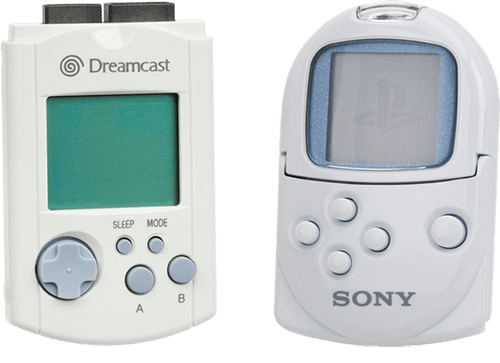
At the beginning of this year, a Twitter user named Paul Hubans shared a screenshot taken by his 87-year-old grandmother at Animal Crossing: after four years of daily games she accumulated 3,580 hours - almost 150 days of total playing time. The ability to save progress and return to the game provided the creation of a surprisingly deep gameplay. But it was not always so. How did we come to this? Let's look at the history of saving games.
But before we begin, a small note: it should be said that home computers, compared to video game consoles, had to make completely different compromises, and they were able to save almost in the very first games. In this article we will look at the history of saving games on game consoles, and it will be much more interesting.
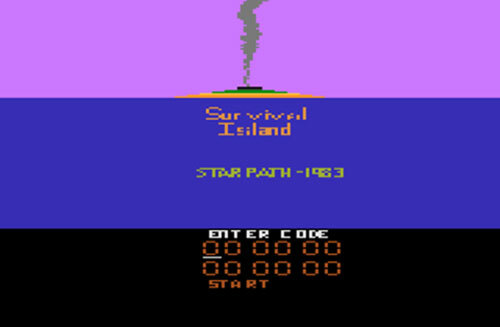
It does not look very good, but the game allowed to continue the gameplay.
Magic words: why passwords became fashionable, and why they were soon forgotten
In the beginning was ... not so much. Video games were simple and abstract — you put a quarter into the Pong machine, you play until you lose, and then you continue with the next life. The very first commercial games were built on discrete logical components, rather than on more functional microprocessors, and this imposed restrictions on the complexity of the gameplay. Fortunately, for people who lived during the dawn of the video games of the mid-1970s, it was more than enough.
')
Everything began to change in the late 1970s, when the cost of microprocessors fell, and home computers became more affordable for the average consumer. This led to the first serious gap in the video game industry: on the one hand, the gameplay of arcade machines and home video consoles is exclusive, on the other, a completely different set of games available on multifunction home computers. Typically, home computers lagged far behind specialized gaming consoles in terms of graphics and sound, but they had an advantage in data storage: at first, thanks to floppy disks, and later - to large hard drives. It took a lot of time for gaming consoles to catch up with computers in this respect, but for now they preferred fast arcade games and avoided deep research gameplay.
Home video game games such as the Atari 2600 and the Nintendo Entertainment System were stored on ROM-readable chipsets. Even if the game developers wanted to offer something more than simple arcade games, they did not have a device to which progress could be maintained.
What they came up with a solution? Passwords
The first home video game with a password system was Survival Island in 1983 for the Atari 2600. Primitive by modern standards, Survival Island had a technical advantage - it had a huge world for research, the ability to collect items and manage inventory, 3D mazes and, of course, passwords, allowed to continue the game from the place where you finished last time. This is one of the few games for 2600 that had a password system.
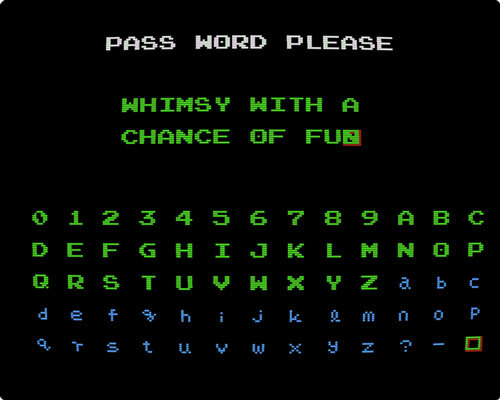
Metroid password set screen.
Truly passwords became popular a few years later, on the Nintendo Entertainment System. NES was a technological leap over the 2600 and could provide a much richer gameplay. Password-enabled games began to appear a year after the appearance of NES in North America, and the first of them was Konami's Castlevania , released in May 1987. By June of the same year, Nintendo itself began advertising the line of games under the “Password Pak” brand at the summer CES . The first two Nintendo games with password support were Kid Icarus and Metroid .
Passwords opened a new level of possibilities in games, but they still limited. Only a fairly small amount of information could be stored in passwords, otherwise they became too long. In addition, writing down even the shortest passwords distracted users from the gameplay. In Japan, both of Nintendo's first two Password Paks were released for the console floppy disk drive, which was distributed only in the Japanese market. Thanks to the use of floppy disks, progress could be saved directly to the game disk, which relieved the players of the need for boring rewriting of passwords on paper.
The world needed another technological breakthrough. How can I record progress on game cartridges, if they are read-only?
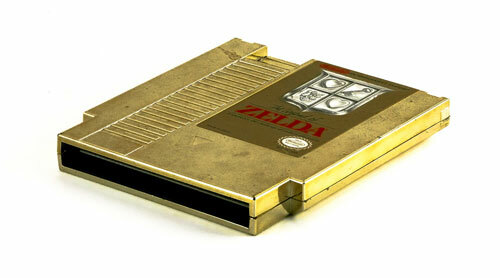
Batteries come bundled: how the memory snuck in on the cartridges themselves
Nintendo announced the next breakthrough on the same show, where it announced the release of Password Pak. The Legend of Zelda , which has already been released in Japan on a floppy disk, will be delivered to North America on cartridges. Instead of passwords, it will use the current system of saving, as in the Japanese version. Nintendo managed to achieve this with a clever engineering trick: she placed a small long-lived battery called a button cell inside the cartridge, which in fact deceived the game: she believed that it was never turned off, and this made it possible to maintain the progress of three different gaming sessions.
The gameplay of the game Pop & Chips, with which you probably do not know.
The Legend of Zelda was not the first battery cartridge (for the first time, Nintendo used this concept in the programming environment for its Japanese console in 1984 ), as it was not the first game with a battery (this honor belongs to the 1985 game Pop & Chips , released on a forgotten console called Super Cassette Vision). Nevertheless, it was a huge step forward. In previous cartridges with battery support, the players themselves had to insert their own AA batteries, which made the cartridges clumsy and heavy. The Legend of Zelda , on the other hand, seemed like a normal game.
Nintendo initially planned to distribute its additional floppy drive around the world, but the hit Zelda , released just a year earlier in Japan, was the last nail in the coffin lid of the disk system. Nintendo Disk System was designed to provide a volume drive for large games and the ability to save player progress, but advances in cartridge technology in just a year turned it into an outdated technology. Cartridge volumes even surpassed floppy disk memory, and with the advent of battery saves, both of the benefits of the disks made it to regular consoles.
Over the next few years, passwords and batteries grew in popularity. At first, passwords were a standard solution for recording simple progress, and batteries were used for more complex adventure and role-playing games. But with the beginning of the 1990s, battery saving became widespread. Of the five games released for the second console of Nintendo in the North American market, two had battery backups.
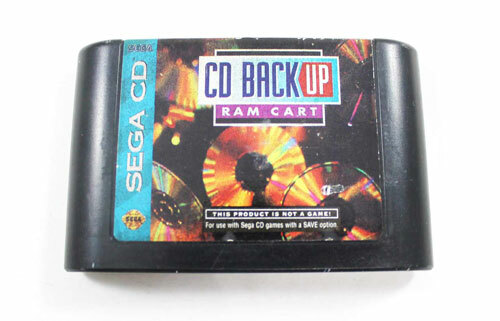
Once upon a time, Sega sold cartridges that did nothing but save games.
Why CD-ROM drives needed a memory card
Cartridges have successfully overcome the threat of obsolescence, but with the advent of a new decade, they faced a new competitor: CD-ROM. First made available to Japanese console gamers in 1988 on an additional NEC device for its PC Engine console (known as TurboGrafx-16 in North America), the technology began to gain popularity in the West after the release of Sega in 1992 for its much more popular Genesis console. . The games on the CD-ROM provided a huge capacity jump, hundreds of times more than any cartridge of that time, but they had an Achilles heel - players could not keep their progress. Unlike cartridges, which were quite versatile and made it possible to embed innovations into plastic cases (for example, battery-preserved), CDs remained CDs. They could not appear new cunning additions.
What was the solution? Continue to use cartridges. Both NEC and Sega added memory to save games to their CD-ROM consoles, but Sega went a little further by inventing its own CD Back Up RAM Cart , which not only increased the storage space for saved games, but also allowed players to transfer saved games to other consoles visiting friends. In fact, the Back Up RAM Cart took the battery-powered save technology from Zelda and put it in a separate cartridge without a game. So the memory card was born.

By the mid-90s, each console had a slot for memory cards, even in those that did not need it.
The following consoles with games on disks happily accepted the concept of memory cards. The new Sega Saturn console used the same “internal memory plus memory cartridge” system as on the Sega CD, but it showed its fallacy. Sony's PlayStation and all other subsequent disk systems used memory cards exclusively. Even Nintendo 64, known for remaining a fan of cartridges in the era of optical discs, had memory cards (however, many of its games still used battery cartridges).

Sega Dreamcast VMU and Sony PocketStation.
Probably the peak of the development of memory cards was the release of the Sega Dreamcast, in which the so-called Visual Memory Units appeared, replacing conventional memory cards. These memory cards themselves were small gaming systems that could not only store saved games, but also download software from the main console.
Japanese advertising game Godzilla for VMU.
VMU provided completely new features. For example, Sonic Adventure allowed you to transfer similar to Tamagotchi "Chao" in VMU, where it was possible to improve their performance without a game console. Sony tried to compete with this functionality by releasing a line of PocketStation peripherals for its PlayStation, but the idea did not “take off”. Therefore, smart memory cards have remained more historical curiosity than a reflection of a new step forward.
“Having released its Visual Memory Unit (VMU), Sega gave birth to the concept of a two-dimensional memory card. Instead of simply storing games in a dull gray piece of plastic, players can interact with it. Explore the dungeons of your favorite RPG or tuning the race car you just won - and all this can be done on the go. ”
Quote from the 1999 article, the first release of Official Dreamcast Magazine , telling about the benefits of VMU , which has become a truly unique device in the history of games (even though Sony tried to steal its success), and its ingenuity is highly appreciated today. (And yes, someone managed to shove a Raspberry Pi inside this device .)

In Nintendo’s F-Zero AX arcade machine, there was a slot for a Gamecube memory card.
One of the advantages of memory cards: they can be taken into the halls of arcade machines
Gamers quickly accustomed to the fact that you can take saved games with you. In addition to the opportunity to share their progress and cooperate, memory cards allowed players to exchange competitive information and records about their playing skills. The developers of arcade games saw this as an opportunity to increase the attractiveness of their projects, which led to the creation of several arcade machines compatible with memory cards.
A very popular example of this was Konami's Dance Dance Revolution ; Some DDR arcade machines were equipped with slots for Sony PlayStation memory cards, allowing players to save settings and records. DDR even provided a certain degree of interaction between home consoles and machine guns: some settings from the game console could be transferred with the help of a memory card to an arcade game.
Nintendo borrowed this idea from F-Zero AX 2003, an arcade version of the F-Zero GX game released the same year on the GameCube. F-Zero AX had a GameCube memory card slot , and it was almost the same as DDR allowed players to transfer settings from their home console to arcade machines.

Xbox 360 hard drive.
Goodbye, memory cards, hello, hard drives: save games on mass storage devices
Despite its convenience, the memory cards had one serious drawback: the low storage capacity. At the turn of the century, the industry switched from battery-powered memory to non-volatile flash memory, the same used by USB flash drives or camera memory cards. Unfortunately, flash memory was extremely expensive at that time, so the memory card volumes were small. Upset gamers had to dig into the contents of their memory cards, trying to find a place for one game by removing the saveings of another.
An alternative to memory cards appeared on the sixth generation of consoles. Microsoft's Xbox went down in history as the first console that came standard with a hard drive, and the PlayStation 2 supported hard drives as additional hardware. Hard drives opened gamers many new features, including almost unlimited storage to save progress in games. The Xbox had traditional memory cards, but their 8 MB capacity was incomparable with 4 or 8 GB hard drives inside the console. The days of the memory card were numbered.
In 2011, the standard for consoles became the mechanisms for preserving to cloud storage . By the time the seventh generation of consoles was released in 2005, both hard drives and network connectivity had become standard. Initially, the network was used only for online multiplayer, but over time, more and more network functions appeared in consoles. For several months of 2011, Sony and Microsoft added the ability to save to the cloud in their consoles, unplugging the save from the physical equipment and allowing the players not to even think about it.
Over the past three decades, saved games have moved from paper to cartridges, then to memory cards, then to hard drives, and then ... somewhere on the Internet. Having moved to the cloud, conservation is likely to have reached its final form. Cloud storage and network connectivity has become so standard that many games just continuously continue to keep progress in the background.
At the same time, we lost something special. Children in the 80s exchanged passwords on sheets of paper. Children in the 90s wore memory cards in backpacks to visit friends. Children in the 2000s received an amazing opportunity to compete with each other anywhere, but lost this small piece of magic that arose when interacting with a precious physical object .
No one would want to go back to where we started, but this is worth remembering. The next time you see the "save ..." animation in the corner of the screen, think about how far we have come. This is really surprising.
Source: https://habr.com/ru/post/443392/
All Articles